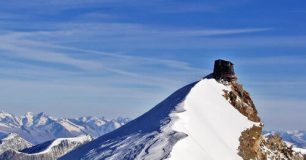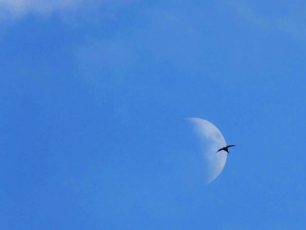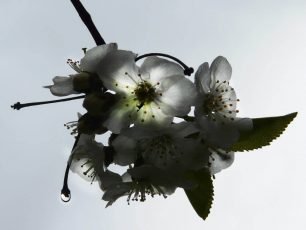Home / The Walser today / Legends, traditions and songs
The Walser world is full of mysterious supernatural presence: curious elves , hidden treasures between the mountains protected by threatening spirits, wild men, processions of the dead and vindictive devils.
The Walser boast about knowing how to foretell destiny in the normality of daily life, of having a magical variegated culture yearning for the freedom of thought, revering their own origins in a whirling universe of legends, fairy tales and true stories that used to liven up the long winter months and which have been kept alive until today thanks to the isolation in which the Walser have lived for nearly a millennium.
When the parish church at Gressoney was built, the devil had a furious fit and decided to destroy that which already had been built. For this purpose he looked for the biggest rock possible, which he found at col d’Olen, to crush Gressoney. Near the hill, alas the tragedy was close at hand, he stopped to rest a while, and at that moment an angel from God appeared and commanded him to let go of the stone. The tired devil, angry as hell and swearing ( in German dialekt: prebet) hit the rock with his fist which started to roll towards Alagna along the valley Olen and stopped about halfway between the hill and Pianalunga. The rock is still there today and has a clear crack, blackened on one side, testimony of a fist punch accompanied by the flames of hell.
On the evening of the 2nd November, from the bottom of the ravines, the riverbeds and the cemeteries in the valley of Mont Rosa, the dead rise and start walking towards their mountain. Each skeleton’s baby finger glows and that little light guides it in the dark. If they meet a human being, they stop him, knight him, give him one wish and a wand to direct the procession. In this way the crowd behind him can proceed rapidly and without any difficulties. If they come across a ravine or a river, the most guilty amongst the departed souls, elongates its arms and legs until it reaches the other side, thus making a bridge for the others to cross. When its hands touch the opposite banks, the row of dead walk over the creaking skeleton and it waits for the crowd to pass. The procession reaches the glacier before sunrise and there, for penitence, they atone for their sins, beating the ice with pins and the sound is carried down into the valleys. The valley inhabitants have always paid attention to the sound in the mountains on the night of the 2nd November and that sound gives them the shivers.
It’s the most famous of all the Walser legends and it tells of a peaceful, happy place where rye grows in abundance and the grass doesn’t turn yellow. It’s on the other side of the glacier and even though it’s existence is certain, the search for it is in vain. It’s a myth of a faraway homeland. In 1778 seven young men of Gressoney set out to look for this valley. They climbed Mont Rosa and reached Colle del Lys. In the thin, high altitude air, clinging to a rock sticking out in the ice, they saw a green valley in the distance. It was the valley of Zermatt. They returned home certain of finally seeing the lost valley. Since then, the rocky spire near Coll de Lys is called Entdeckungsfeld, or Discoverer’s Rock.
Baptisms are always held on a holiday with the sound of bells ringing everywhere. Each baby had a god-father, an older god-mother and a young god-mother. The god-mother and father were the real testimonies of the sacrament. In ancient times, the young god-mother was a young girl wearing a white apron, who carried the baby to the front door of the church. The baby who lay in a cradle set on the girl’s head and ringtied by a handkerchief to keep it stable was placed on the ground at the church door. When the parish priest arrived with the altar boys carrying lit candles, the god-mother and father removed the newborn from the cradle and put it in the arms of the young god-mother, then the priest placed his stole on the baby’s heart and the older god-mother put her hand on the stole until the priest blessed the baby. At the end of the blessing, those present entered the church. At the baptistery the priest put some salt in the baby’s mouth and poured holy water onto its head while saying its chosen name.
In the evening at the first sign of dusk, the children lit many little bonfires at various heights of the village, as if to create a crown of lights accompanied by folk singing and making characteristic nature call sounds (huru). The fires were called “Ave Maria”. When the tall flames reached towards the sky, they danced around the bonfires, singing and shouting to make themselves heard by other hamlets who answered with the same calls.
The Walser boasts of having the capacity to know who will die next by reading distinctive signs, for example, water dripping in a house and it’s not raining outside; a howling fox or one crossing your path and looks back at you; small wind disturbances that lift hay or snow high up in the air, while the air around before was calm. But at someone’s death bed, they were much more pragmatic and in the face of agony, they had a prayer ready.
Oh Man, I put a light in your hand so that today you may assist destiny as it might be hostile towards you. I implored good Saint Joseph, good Saint Steven and good Saint Michael, to carry your soul into the immensity of Paradise, at the eternal Mass and at the holy encounter with God in the sky, where the Lord talks and sings. Don’t be afraid and don’t knock, the door will be opened for you. You will find three roads that look like one: one white, one red and one golden red, this is the one you have to take and all things in the name of the Father, Son and the Holy spirit, Amen."
After a death, funeral demonstrations followed a precise ritual : immediately after the death, family and friends gathered to pray in the deceased person’s house. The evening before the funeral each family sent a representative to the wake during which they handed out bread, cheese and wine to all participants and waited with them until morning, while reminiscing and chatting. The day of the funeral, the corpse closed in the coffin was carried on the shoulders of the men to the cemetery. At the end of the funeral one ration of rice was given to each family present, with the aim of reminding them to support the souls of the departed. The funeral feast followed the burial.
A very particular Walser tradition concerns the window of the soul “seelaballga o seelenbalggen). There is a small aperture in the wall of the stube (parlour) that was opened at the death of a loved one to free the soul directly towards the glacier of Mont Rosa to purge their sins committed in life. The window was closed immediately afterwards so the soul could not find its way back inside.
The Walser national anthem
Many, many centuries ago
They’ve gone beyond the trails, into foreign soil
They’ve abandoned their native valley
And settled in faraway places
But the Walser ways and Walser blood
Is well-preserved in foreign soil
It’s not known why the Walser people
Have ventured so far away
Did they have to migrate or did they want to go,
Who knows why today?
But the Walser ways and the Walser blood
Is well-preserved in foreign soil
Thoughts are free/ Who can ever know them?/ They pass like a whisper,/ like an evening shadow,/
nobody can know them,/ no hunter can kill them,/ no it’s been agreed:/ thoughts are free
I think what I want/ and think what I like,/ but all in silence, /as must be,/my wishes, my hopes,/nobody can stop them,/so it’s been agreed: /thoughts are free./ Lock me in the /darkest dungeon, too,/but all’s in vain/because my thoughts/will break down the barriers/ pass thru’ the wall./ Thoughts are free/ I now want to give up/ love forever/ and I don’t want to ever torment myself with irrational fear/ each one can laugh/ and joke in his heart;/ and think;/ thoughts are free/ I love wine,/ but most of all, my girl,/ most of all, I love her,/ I am never alone/ with a glass of wine/ and my girl, beside me/ thoughts are free
Oh my love come here
I’ll offer you coffee
and also a litre of beer
To lay down with you
No coffee no beer
You’ll pay for me,
because I will sleep near you
all the same
I’ll be very happy,
if you’ll sleep near me,
I’ll pay the coffee
and the beer all the same
There was once a hunter, Who hunted with a golden bow, He hunted all morning long, until the sun came up. Iohei! Oh mother, oh dear mother, give me your good advices should I accept the hunter
or should I leave him? Iohei! Oh daughter, oh dear daughter the advice I give you is: leave the hunter to hunt, and take the manor lord’s son. Iohei! Oh mother, oh dear mother, I don't like your advice, the hunter is more dear to me, than a castle and all the land, Iohei!
If the hunter is more dear to you, than a castle and all the land, then tie up all your clothes and go,
far away with him. Iohei!


Notifications



